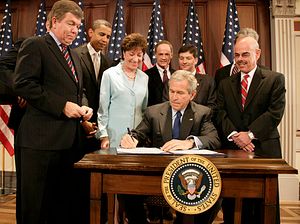On Tuesday, Michael Lumpkin, U.S. assistant defense secretary told Congress that the United States needs to “re-look” at the Authorization for Use of Military Force (AUMF) — the ominously named law was passed almost unanimously (1 nay vote in all of Congress) by both the House and the Senate following the September 11, 2001 terrorist attack against the World Trade Center (not to be confused with the similarly named law that authorized the Iraq invasion in 2002). Since then, the AUMF has been a controversial feature of the U.S. War on Terror, allowing for all sorts of constitutional flexing that would otherwise be illegal.
Lumpkin’s suggestion isn’t outrageous but would have important implications for the scope and manner in which the United States continued to fight terrorists across the world. Although the AUMF was a feature of the Bush administration, the Obama administration has continued to reap the benefits of the law in terms of the flexibility it affords the executive branch, the Pentagon, and the intelligence community in pursuing and eliminating terrorists. At the core of the AUMF is the notion that the “the President is authorized to use all necessary and appropriate force against those nations, organizations, or persons he determines planned, authorized, committed, or aided the terrorist attacks that occurred on September 11, 2001, or harbored such organizations or persons, in order to prevent any future acts of international terrorism against the United States by such nations, organizations or persons.” To translate the legalese, in essence, the President of the United States is free to pursue, with military force, any individual, group, state, or other institution affiliated with al-Qaeda.
The U.S. invasion of Afghanistan was the first outcome of the powers afforded to the executive branch by the AUMF. In recent memory, the United States’ remotely piloted aircraft (“drone”) campaign against al-Qaeda affiliates in Yemen and Pakistan is able to occur because of the AUMF.
In his statement, Lumpkin notes: “I think that we’re at a point where while the AUMF has supported the needs of the department in order to execute the missions at hand in order to protect the homeland and American interests, I think we’re at an inflection point that it may be a time to look at the AUMF to see if it does need adjustment to better serve this country.” On the surface, this is murky and indeterminate. Different political groups in the United States have very different ideas about the direction the AUMF should take going forward. President Obama is keen to normalize the United States after over a decade of pursuing terrorists worldwide; that said, the benefits of a flexible law such as the AUMF are apparent and beneficial.
The AUMF, however, isn’t the sort of legal Swiss army knife that some would like it to be. Following the devastating attack on the U.S. Consulate in Benghazi that resulted in the death of U.S. Ambassador Christopher Stevens, Gen. Martin Dempsey stated that the United States was unable to pursue the attackers because they were outside of the scope of the AUMF. The Pentagon and hawks in Congress are interested in allowing the AUMF increased maneuverability so that it can be used to target threats to the United States that are only loosely linked to al-Qaeda.
The AUMF became a point of controversy among libertarians, non-interventionists, and civil rights groups once it became apparent that it offered a legal smokescreen to pursue extra-judicial assassinations of American citizens affiliated with al-Qaeda, denying them the right to due process. The United States’ widely condemned practice of indefinite detention of “enemy combatants” is also a result of the AUMF.
Overall, there seems to be no political consensus about what the AUMF should become. I reckon that Lumpkin’s right that the AUMF needs to be “re-looked” at. The timing is rather impeccable considering that the United States is formally ending its war in Afghanistan this year. President Obama himself noted in a speech at the National Defense University last year that he looks forward “to engaging Congress and the American people in efforts to refine, and ultimately repeal, the AUMF’s mandate.”
Those who disagree with repealing the AUMF note that it would regress the United States’ counter-terrorism readiness to “a law-enforcement model of counterterrorism.” There is some truth in that assertion. However, the United States’ national security apparatus has matured significantly since 9/11 and the failures in intelligence and lack of inter-agency communication that allowed that attack to happen have had time to be patched up.
The future of the AUMF will have important ramifications for the manner in which the United States pursues non-state national security threats in the future. Expect this debate to expand as President Obama’s second term carries forward.

































